Spruce is a coniferous tree belonging to the Picea genus of the Pinaceae family, which contains 35 species. The tree looks similar to pine and grows in the same types of areas. It grows slowly until its 15th year and at its fastest between its 40th and 60th year.
Spruce is a straight, slender tree. Its trunk reaches up to 311 ft (95 m) high and up to 13 ft (4 m) wide. The bark of young trunks is smooth, grey-green, sometimes turning grey-brown and cracking. Spruce lives a long time, sometimes up to 1000 years. Spruce has shallow roots beneath the soil. The crown is also like a pine's but in the case of spruce, branches grow near the ground, while the lower branches of pine dry up and break off from the wind.
One example is the Norway spruce (Picea abies), usually found on the northern slopes of mountains since it requires constantly moist soil and air. It is a coniferous tree, reaching up to 164 ft (50 m) tall. The needles are 4-angled, up to 1 1/2″ (3.5 cm) long, densely arranged around the entire circumference of the branches.
The reproductive organs of the tree are unisexual, monoecious. The cones are cylindrical, reaching up to 6″ (15 cm) in length, 1 1/2″ (4 cm) in width, the cone seeds are oval, narrowed to a wedge at the base.
Types of Spruce
Blue spruce reaches up 164 ft (50 m) tall and has a conical crown with a layered structure. The bark is grey-brown, which cracks severely and darkens in older trees. The leaves are up to 1 1/4″ (3 cm) long, hard with a pointy end, arranged radially, splayed out in all directions on the shoots. They are covered with a silver wax coating, with the saturation changing depending on the different forms and environmental conditions. Some forms have such a highly saturated silver coating that the trees look nearly white. The cones can reach 4″ (10 cm) in length, are cylindrical and light brown. This species is found in North America, the Rocky Mountains, in the mountains of the states of Utah, Colorado, at altitudes between 6560 ft (2000 m) and 10496 ft (3200 m).
Serbian spruce (Picea omorica) is a tree reaching up to 131 ft (40 m) tall with a dense, slender, conical crown, pointed at the top. Its branches are very short, hanging. The bark is dark brown, with young branches having hair. The leaves are short - no longer than 3/4″ (2 cm), with the middle shoot sticking out, dark green on the top, greyish on the bottom, giving the crown a slightly silver color. The cones are no longer than 2 1/2″ (6 cm), violet before ripening and brown after. Serbian spruce is naturally distributed within the limits of Southeast Serbia and Bosnia.
The dwarf Alberta spruce (Picea glauca conica) is a small evergreen tree, reaching up to 6.5 ft (2 m) tall. This type originates from Canada.
This small spruce is very common in gardening. Its needles are up to 1/2″ (1.5 cm) long, gentle. It forms a perfectly conical and highly dense crown and is a completely winter hardy plant. It has silver, bluish and green forms.
The Caucasian spruce (Picea orientalis) is a spruce belonging to the Pinaceae family. Its leaves grow up to 1/2″ (1 cm), almost square or slightly rhombic in cross-section, very firm and shiny green on the outer facing shoots. The young branches are shiny and light brown, densely packed with short trichomes. The cones are brown, up to 4″ (10 cm) long. The scales are rounded with a whole upper edge.
Composition of Spruce
Spruce bark contains tannins, balsams and others. The wood has a complex mixture of various organic compounds, as well as uronic acid and remnants of arabinofuranose. The needles of spruce contain essential oils, the makeup consisting of up to 12% bornyl acetate, α-pinene 1, p-pinene and others.
The shoots also contain significant amounts of essential oil, with the contains having bornyl acetate and other esters. The seeds contain up to 33% fast drying fatty oil, the composition of which includes about 5.2% linolenic, about 15.7% α-linolenic, about 29.5% α-linoleic, about 23.6% p-linoleic and about 11.4% fatty acids. They also contain 22% raw protein, about 12% nitrogen-free extract substances and others.
Growing Spruce
Spruce has constant need of high air humidity and rich, moderately humid soils. It is resistant to the winter chills, has an average tolerance to limestone in soil. It has exceptionally beautiful decorative forms - low growing, drooping, spherical and conical. It can be planted in a yard like a Christmas tree.
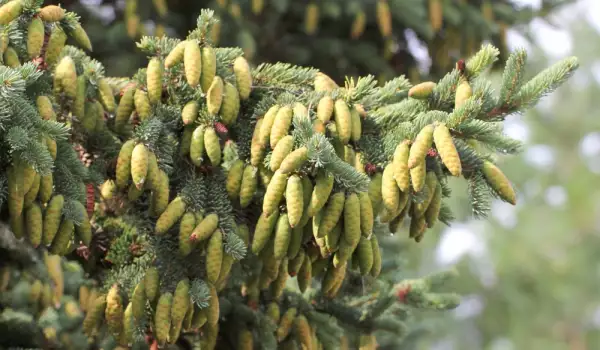
Spruce propagates through seeds. In mid-April, dip the seeds in minium so that they turn almost red. Then put them in moist sand for 8-10 days until they begin to sprout. Then plant them in loose and moist soil in a well-lit area but not in direct sunlight. Lay on 1/4″ (0.5 cm) of fine sand on top. 50-70% of all seeds will sprout. Germination of the seeds is possible for up to 10 years.
Choosing and Storing Spruce
The cones ripen during the fall of the first year. They need to be picked when the seeds become visible behind the scales. The cones of Norway spruce need to picked in January, of Serbian spruce - January and February, of Blue spruce - at the end of August. If collecting needles during the winter, choose the lightest green ones. They are the youngest and freshest. Wash them well and scrape them off the shoots with a sharp knife. Next, cut them finely. Sometimes, spruce roots are also collected for medical purposes.
Benefits of Spruce
Folk medicine uses young spruce branches, which are collected along with the buds, cut up while still fresh and boiled with sugar. The resulting syrup is an effective remedy against coughing and other inflammation of the lungs, as well as against rickets, scurvy and more.
Extract from fresh spruce needles can be added to bathwater for children, for freshening and for all kinds of eczemas. The essential oil from the different parts of the herb is widely used in medicine, the perfume industry and cosmetics.
Dry distillation of the wood produces a series of articles important for medicine and industry, such as resin, turpentine, rosin and others. Fatty oils from spruce seeds find wide application in linseed oil and lacquer production, and can be adapted for burning as well.
Besides for building materials, woodworking and others, the wood is also used for making medicinal activated charcoal (Carbo activatus), which is used as an absorbent substance and antidote for alkaloid and phosphorus compound poisoning. The bark is used to make tanning materials for tanneries and medical colophony tar, wood vinegar.
The aroma of burning dried conifer branches is considered a good method for cleansing the home from negative influences. Few know about the amazing healing effects of Norway spruce cones. The more you have at home, the healthier and cleaner the air you breath will be. Collect cones for the winter but don't pick them from the tree, just gather the ones that have already fallen on the ground around it.
It is thought that by holding a spruce cone between our palms we will quickly get rid of the negative energy accumulated in our body. An incredibly effective method is to touch wounded or diseased areas of the body with cones after a shower since they alleviate pain, while surface wounds will heal faster. If we plant spruces in our garden, they will create a defensive shield that will protect against the evil eye and negative energy.
Folk Medicine with Spruce
According to folk medicine, a concoction from the needles, branches and cones of spruce strengthens the immune system. Baths with spruce are suitable for nervous disorders and exhaustion. Infusions from the cones are administered for angina, pneumonia, asthma and as a prophylactic against acute respiratory diseases.
Try this folk medicine recipe for a remedy made from spruce tips: Wash and cut the tips (3 tbsp) finely. Boil 12 1/2 cups (3 L) water and boil the tips for 10-15 min, then strain through a gauze and strainer. Sweeten with honey if desired.
Dangers of Spruce
Spruce remedies are not recommended for pregnant women.
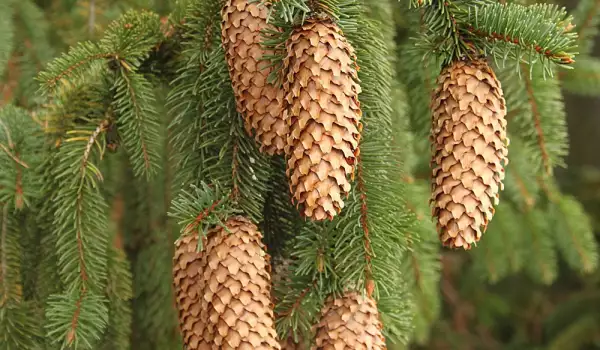


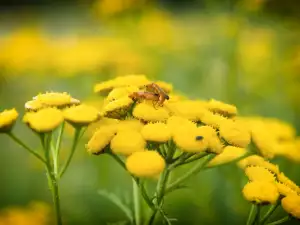



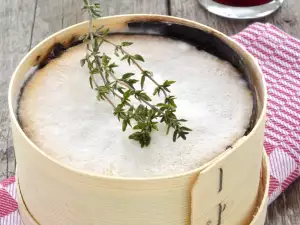


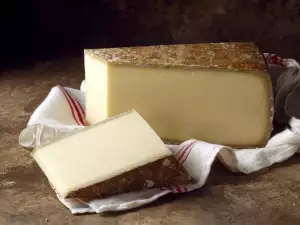
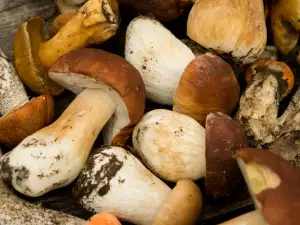
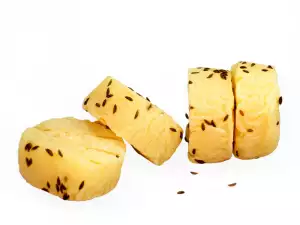

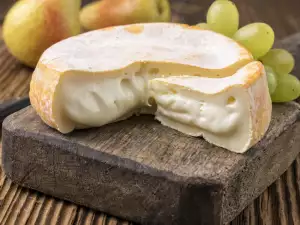
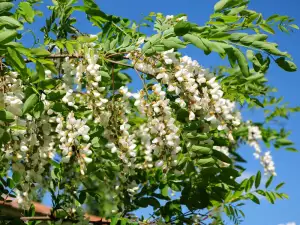
Comments